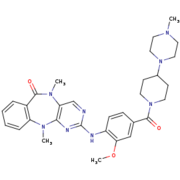User:Estelle Metzger/Sandbox
From Proteopedia
(Difference between revisions)
| Line 46: | Line 46: | ||
== Relevance == | == Relevance == | ||
| - | LRRK2, for leucine-rich repeat serin/thereonin kinase 2, is a protein from the Roco family of G-proteins. It takes part in divers pathway such as synaptic vesicule trafficking, retrograde trafficking pathway for recycling protein or the CaMKK/AMPK pathway. Its importance comes from the fact that its susspetced to have a role in the phosphorylation of a central protein in the Parkinson’s disease.<ref name="uniprot"/ref> Indeed, mutation associated with Parkinson Disease can be found in asmost every domains of LRRK2. For techrapeutic research Rocco4 from the Dictyostelium was mutated, especially in the active site, in order to mime LRRK2.<ref name="Bernd"/> | + | LRRK2, for leucine-rich repeat serin/thereonin kinase 2, is a protein from the Roco family of G-proteins. It takes part in divers pathway such as synaptic vesicule trafficking, retrograde trafficking pathway for recycling protein or the CaMKK/AMPK pathway. Its importance comes from the fact that its susspetced to have a role in the phosphorylation of a central protein in the Parkinson’s disease.<ref name="uniprot"> [http://www.uniprot.org/uniprot/Q5S007 UniProtKB - Q5S007 (LRRK2_HUMAN)], Retrieved on January 27th 2017.</ref> Indeed, mutation associated with Parkinson Disease can be found in asmost every domains of LRRK2. For techrapeutic research Rocco4 from the Dictyostelium was mutated, especially in the active site, in order to mime LRRK2.<ref name="Bernd"/> |
== Disease == | == Disease == | ||
| - | The Parkinson’s disease is a neurodegenerative disorder that is associated with resting | + | The Parkinson’s disease is a neurodegenerative disorder that is associated with resting tremor, bradykinesia, rigidity and postural instability.UNI This is the second most common neurodegenerative disorder, which is affecting 2% of the population above 65 years<ref name="Bernd"/>. |
Two types of Parkinson’s disease existe, the heditary or the sporadic also called idiopathic. LRRK2 mutations can be found in almost its every domains for both types. The most important mutation is the G2019S, which is located on the kinase domain. It stabilise the domains, thus leading to an indresed kinase activity of 2 to 4 fold. That’s why a treatment stategy would be to develop a kinase inhibitor in order to counter it.<ref name="Bernd"/> | Two types of Parkinson’s disease existe, the heditary or the sporadic also called idiopathic. LRRK2 mutations can be found in almost its every domains for both types. The most important mutation is the G2019S, which is located on the kinase domain. It stabilise the domains, thus leading to an indresed kinase activity of 2 to 4 fold. That’s why a treatment stategy would be to develop a kinase inhibitor in order to counter it.<ref name="Bernd"/> | ||
The use of roco4, permited to learn that the G2019S mutation is the results of an additional hydrogen bound between Ser2019 (Ser1179 in Roco4) and Gln1918 (Arg1077 in Roco4).<ref name="Bernd"/> | The use of roco4, permited to learn that the G2019S mutation is the results of an additional hydrogen bound between Ser2019 (Ser1179 in Roco4) and Gln1918 (Arg1077 in Roco4).<ref name="Bernd"/> | ||
Revision as of 08:12, 27 January 2017
Humanized Roco4 bound to LRRK2-IN-1
| |||||||||||
References
- ↑ 1.00 1.01 1.02 1.03 1.04 1.05 1.06 1.07 1.08 1.09 1.10 Gilsbach BK, Messias AC, Ito G, Sattler M, Alessi DR, Wittinghofer A, Kortholt A. Structural Characterization of LRRK2 Inhibitors. J Med Chem. 2015 May 1. PMID:25897865 doi:http://dx.doi.org/10.1021/jm5018779
- ↑ 2.0 2.1 2.2 2.3 2.4 Gilsbach BK, Kortholt A. Structural biology of the LRRK2 GTPase and kinase domains: implications for regulation. Front Mol Neurosci. 2014 May 5;7:32. doi: 10.3389/fnmol.2014.00032. eCollection, 2014. PMID:24847205 doi:http://dx.doi.org/10.3389/fnmol.2014.00032
- ↑ 3.0 3.1 doi: https://dx.doi.org/10.1016/S0092-8674(02)00741-9
- ↑ 4.0 4.1 Taylor SS, Kornev AP. Protein kinases: evolution of dynamic regulatory proteins. Trends Biochem Sci. 2011 Feb;36(2):65-77. doi: 10.1016/j.tibs.2010.09.006. Epub, 2010 Oct 23. PMID:20971646 doi:10.1016/j.tibs.2010.09.006
- ↑ UniProtKB - Q5S007 (LRRK2_HUMAN), Retrieved on January 27th 2017.


